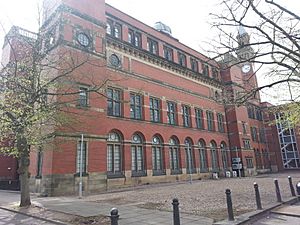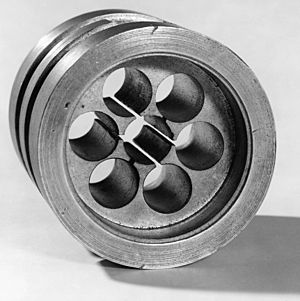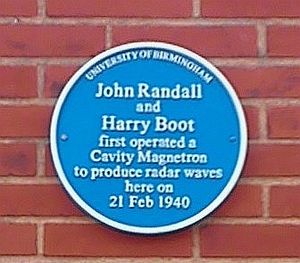John Randall (physicist) facts for kids
Quick facts for kids
John Randall
FRS FRSE
|
|
|---|---|
| Born |
John Turton Randall
23 March 1905 Newton-le-Willows, Lancashire, England
|
| Died | 16 June 1984 (aged 79) |
| Alma mater | Victoria University of Manchester (BSc, MSc) |
| Known for | Cavity magnetron DNA structure determination neutron diffraction studies of labelled proteins |
| Awards |
|
| Scientific career | |
| Fields | Physics Biophysics |
| Institutions | General Electric Company plc University of Cambridge King's College, London University of St Andrews University of Birmingham University of Edinburgh |
| Doctoral students | |
Sir John Turton Randall (born March 23, 1905 – died June 16, 1984) was an English scientist. He was a physicist and biophysicist. He is famous for two big things. First, he greatly improved the cavity magnetron. This device was vital for radar during World War II. It also makes your microwave oven work today! Second, he led the team at King's College, London that worked on figuring out the structure of DNA.
Randall worked with Harry Boot to create the magnetron. This invention could send out powerful bursts of microwave energy. A historian named David Zimmerman said that the magnetron "changed the course of the war." It allowed for better radar systems on planes. It is still a key part of microwave ovens.
Randall's team at King's College studied DNA. His colleague, Professor Maurice Wilkins, shared the 1962 Nobel Prize for Physiology or Medicine. He shared it with James Watson and Francis Crick. They won for discovering the structure of DNA. Other important scientists on Randall's team included Rosalind Franklin and Raymond Gosling.
Contents
Early Life and School
John Randall was born on March 23, 1905. He grew up in Newton-le-Willows, England. He was the only son of Sidney Randall, who sold plants and seeds. John went to grammar school in Ashton-in-Makerfield.
He then studied at the Victoria University of Manchester. In 1925, he earned a top degree in physics. He received his Master of Science degree in 1926. In 1928, he married Doris Duckworth.
Career and Discoveries
From 1926 to 1937, Randall worked for the General Electric Company. He helped create special powders that glowed in lamps. He also studied how these materials glowed.
By 1937, he was a leading expert in his field. He received a special award from the Royal Society. He then worked at the University of Birmingham. There, he studied how light makes materials glow, working with Maurice Wilkins.
The Magnetron: A Wartime Invention

When World War II started in 1939, scientists needed better radar. The British Navy wanted a radio source that used microwaves. This would help radar spot small objects, like U-boat periscopes. The Air Force also wanted a 10 cm system. This would make radar antennas much smaller. They could then fit easily inside airplanes.
Scientists first tried using a device called a klystron. Klystrons could make microwaves, but they were not very powerful. Randall and Harry Boot were asked to find a way to make a stronger microwave source. They tried some older designs, but they didn't work well for microwaves.
Randall and Boot then looked at another device called a split-anode magnetron. It wasn't very efficient. But it used a simple hot wire to create electrons. This meant it could potentially handle much more power.
They had an idea to combine the best parts of the klystron and the magnetron. They thought about replacing the flat plates in the magnetron with special metal shapes called resonators. These shapes would make the electrons move in a circle. As electrons passed by the resonators, they would create microwaves much more efficiently. They realized they could add many resonators. This would make the device more powerful and efficient.
In February 1940, they tested their new design. It was called the cavity magnetron. They used a copper block with six holes drilled in it. They placed it in a vacuum and put it between two strong magnets. Their first test produced 400 watts of power. Within a week, it reached over 1,000 watts!
Engineers from GEC helped improve the design. They made the tube stronger and added a better electron source. This boosted the power to 10,000 watts. This was as much power as older radar systems used. The magnetron changed radar forever. Most new radar sets from 1942 onwards used this invention.
In 1943, Randall moved to the Cavendish Laboratory at Cambridge. In 1944, he became a professor at the University of St Andrews. He started planning research in biophysics with Maurice Wilkins.
King's College, London: Unraveling DNA
In 1946, Randall became the head of the Physics Department at King's College, London. He set up a special research unit there. This unit focused on biophysics, which combines biology and physics.
During his time as director, his team made a huge discovery. They worked on finding the structure of DNA. Key scientists in this work included Rosalind Franklin, Raymond Gosling, Maurice Wilkins, and others. Randall assigned Raymond Gosling to work with Rosalind Franklin. They used X-ray diffraction to study DNA.
Raymond Gosling said that John Randall's role in the DNA discovery was very important. Randall strongly believed that DNA held the genetic code. He put together a team of experts from different fields to prove it. Randall also gave important advice on how to get clearer X-ray images of DNA.
Maurice Wilkins shared the 1962 Nobel Prize for Physiology and Medicine. He shared it with James Watson and Francis Crick. Sadly, Rosalind Franklin had passed away from cancer in 1958.
Besides the DNA work, Randall's unit did other research. They used new types of microscopes. This led to an important idea in 1954 about how muscles contract. Randall also helped bring together biology and physics teaching at King's College.
In 1951, he started a large team to study collagen. This is a protein found in connective tissues. Their work helped explain the three-chain structure of the collagen molecule. Randall himself used the electron microscope. He studied tiny structures like spermatozoa and then focused on collagen. In 1958, he published a study on tiny one-celled organisms called protozoa.
Later Years and Family
John Randall married Doris Duckworth in 1928. They had one son, Christopher, born in 1935.
In 1970, Randall moved to the University of Edinburgh. There, he formed a new group. They used advanced methods, like neutron diffraction, to study biological molecules. This helped them understand how proteins work.
Awards and Recognition
- In 1938, he received a Doctor of Science degree.
- In 1943, he and Harry Boot won the Thomas Gray memorial prize for inventing the cavity magnetron.
- In 1945, he received the Duddell Medal and Prize. He also shared a payment for the magnetron invention.
- In 1946, he became a Fellow of the Royal Society (FRS). He also received the Hughes medal that year.
- In 1958, he and Boot received the John Price Wetherill Medal. In 1959, they received the John Scott Medal. Both were for their work on the magnetron.
- In 1962, he was made a knight, so he became "Sir John Randall."
- In 1972, he became a Fellow of the Royal Society of Edinburgh (FRSE).



